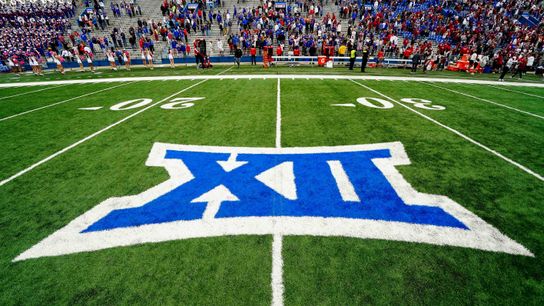It sounds like something out of a prophecy in a fantasy novel: in an effort for the 10-team Big 12 to return to its rightful 12, it must first go to 14.
BYU, Cincinnati, Houston and UCF will come aboard in 2023, and, as far as anyone knows, Texas and Oklahoma will remain in the league through the 2025-26 academic year.
Which means, per NCAA rules, the 14-team iteration of the conference must split into divisions in order to keep its lucrative title game. As Dennis Dodd reports for CBS Sports, this arranged second-marriage of a conference is hard at work figuring out an alignment that makes sense.
"We've got subcommittees in several sports that are talking about structure," commissioner Bob Bowlsby told Dodd. "Conference office, staff, ADs, sports administrators and coaches involved on a sport-by-sport basis, they're all doing the same thing."
The original Big 12 split tidily into two 6-team divisions. The four Texas and two Oklahoma schools in the South; Nebraska, Iowa State, Mizzou, Colorado and the two Kansas schools in the North. When the league formed, in 1996, Nebraska was coming off back-to-back national championships, while Colorado finished 1995 at No. 5, Kansas at No. 9, Texas at No. 14, Texas A&M at No. 15, and Texas Tech at No. 23.
If you're looking for an even 7/7 split, the Big 12 Plus 2 could reform into a North/South alignment, but this feels a bit like putting on your high school jeans. An odd fit no matter how you look at it.
Big 12 South
Houston
Texas
Baylor
TCU
Texas Tech
Oklahoma
Oklahoma State
Big 12 North
BYU
Kansas
Kansas State
Iowa State
Cincinnati
West Virginia
UCF
Houston, Baylor, TCU, Tech and Oklahoma State no doubt favor this (it's unlikely anyone cares about what the Red River Rivals think at this point), but no one in the North does. Plus, does keeping one division geographically intact make sense if it stretches the other from Provo to Orlando? (Not to mention, UCF will be the Big 12's southernmost school upon its entrance.)
Okay, how about this?
Big 12 East
UCF
West Virginia
Cincinnati
Iowa State
Houston
Kansas
Kansas State
Big 12 West
Texas
Baylor
TCU
Texas Tech
Oklahoma
Oklahoma State
BYU
It makes sense geographically... but does it make sense financially? Competitively? Does it make business sense? And most importantly, does it make sense financially?
With a maximum of three seasons to play at that point, the Big 12 will squeeze every ounce of value out of Texas and OU before they're gone. Forever. You can bet the Remaining 8 will want the Longhorns and the Sooners once, and maybe twice, in their stadiums before 2026 arrives, and the Incoming 4 will want them both as well.
That's why I think the Big 12 splits into a Legends/Leaders, Atlantic/Coastal alignment once the four newcomers are aboard.
Big 12 Beef
Texas
Texas Tech
Baylor
BYU
Iowa State
West Virginia
Cincinnati
Big 12 Wheat
Oklahoma
Oklahoma State
Kansas
Kansas State
TCU
Houston
UCF
Slice the pie up as many ways as you want, but splitting Texas and Oklahoma in different divisions serves the conference's short- and long-term interests. In the short term, this guarantees each Big 12 school would host UT or OU at least once. In the long term, splitting the Red River Rivals prevents the conference from having to re-realign come 2026. If Texas and OU wind up in the same division from 2023-25 (assuming they're still in the conference by then, of course), their departure would leave one division with seven teams and the other with five.
There's no NCAA rule that requires the Big 12 to keep its divisions and hold a championship game once it contracts back to 12 in 2026, but a Beef/Wheat alignment at least preserves that option.
And before you ask, no, splitting the Longhorns and Sooners wouldn't temporarily halt the Red River game at the Cotton Bowl each October. That game attracts around 6 million viewers each year, which is still a boon to the Big 12, and it creates an opportunity for a Red River Rematch in the championship game each December.
No matter how the league splits itself in the near and distant future, one thing is certain. Even without Oklahoma and Texas, the Big 12 will be a competitive and compelling watch week-in, week-out.
In the final 2021 rankings, the Big 12 3.0 boasted No. 4 Cincinnati, No. 5 Baylor, No. 7 Oklahoma State, No. 17 Houston, and No. 19 BYU, a showing bested only by the SEC and the Big Ten. Texas Tech and K-State both whipped SEC teams in their bowl games; and Iowa State and UCF aren't far removed from New Year's Six wins. Oh, and Kansas beat Texas.
